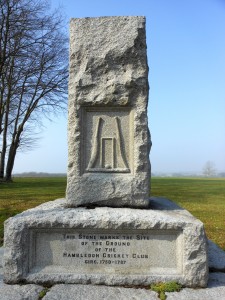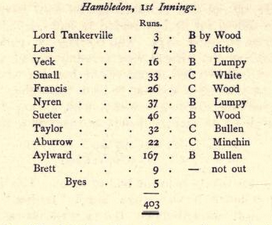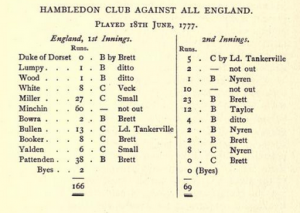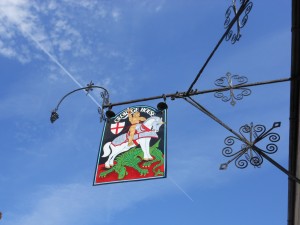Hambledon and Cricket, the two words are synonymous and all those who profess to know the sport will know that this Hampshire village was at the core of the modern game.
Hambledon cricket, the village is quite entitled to its position in the history books because even if it was not the place where cricket was first played, it undoubtedly spawned a club who gave the England team quite a drubbing.This little village in 1777 mustered a team that beat the best that the rest of England could gather together together and so its legacy was set in stone.The centre of this cricketing phenomena was the Bat and Ball public house, whose landlord in the middle of the C18th was Richard Nyren who, along with his son John who was born in 1764, formed a hub of enthusiasm, passion and talent around which the club was based.
The setting for the club, was originally Broad – Halfpenny Down, with the Bat and Ball opposite. The link between cricket green and public house still so symbolic of English cricket to this day.
Quite when the game started to be played in Hambledon is unclear but references to the club appear in local newspapers as early as the 1750’s. One would suppose that even at this time it was quite well established, given the extraordinary talent that seems to have found its way into the team by 1770.
At some point the village club struck out in an altogether different direction. Between 1770 and 1780, there seems to have been a subtle but powerful change in approach, towards a more scientific bent, where technique and training were considered vital.
- All this is known because of the literary efforts of John Nyren, who became player, chronicler and recorder for the club. He kept score sheets and descriptions of the meetings, held weekly at the Bat and Ball.
- He also wrote the now famous book on cricket, ‘Cricketers of My Time’, or at least collaborated with the Shakespearean scholar, Charles Cowden Clarke, to write it for him. This was followed by the ‘young Cricketers Tutor’,still described as the greatest study of cricket and cricketers ever written.
- The ‘golden time’ of the club being between 1772- 1796, when the match between Hambledon and the England club, took place at Sevenoaks with thousands of people watching.
- The match was emphatically won by Hambledon 168 runs and an innings.
- The team members of the club, ranged from the poor, people such as the Walker brothers to aristocrats such as Lord Tankerville but such social separation was no barrier, it did not matter, the purpose was the game.
- Richard Nyren the ‘General’ as he was known moved from the Bat and Ball to the George Inn in the village and the ground was moved to Windmill Down in 1782.
- Hambledon gave the game the foundation for its rules regarding issues such as bowling (Nyren’s stance on underarm bowling is well known), the three stump wicket and the width of the bat. Indeed a wire frame was made and kept at the club to measure the width of the other team’s bats.
- The names of these cricketers Small, Abburrow, Nyren, White still have a presence in local families even today. Some are buried in the local churchyard but thanks to Nyrens work are not forgotten.
- John Nyren himself made appearances not just for Hambledon but also for England
- When he left hambledon and the club in 1791, it seemed the club went into decline, although it might also have been that the MCC, which was set up in 1787 and took over the role of setting the rules of English cricket signaled its demise
- Hambledon cricket continued to be played into the C19th but little was recorded as it had been, under John Nyren.
The ground on Broad-Half Penny Down, is still played on and is the home to Broad-Halfpenny Brigands Cricket Club who play regular fixtures there.The Brigands manage the ground and its facilities on behalf of the Broadhalfpenny Down Association which was formed in 1996 by the Brigands and Winchester College who own the ground.
Read John Nyrens book and other matter drawn from various sources, online as an ebook.
Or here are a selection of books written on the history of the Hambledon Cricket Club
Arlott, John (ed.), ‘From Hambledon To Lords The Classics of Cricket’, 1948 (includes John Nyren’s “The Young Cricketer’s Tutor”)
John Goulstone, ‘Hambledon: The Men and the Myths’, 2001, Roger Heavens, Cambridge
Lucas, E V, ‘The Hambledon Men’, 1907
Mote, Ashley, ‘The Glory Days of Cricket: the Extraordinary Story of Broadhalfpenny Down’, 1997, Robson Books Limited.
Nyren, John, ‘The Cricketers of My Time’, 1833 (collected and edited by C C Clarke together with “The Young Cricketer’s Tutor” above).
Swanton, E W, ‘The World of Cricket’, 4th edition, 1967




